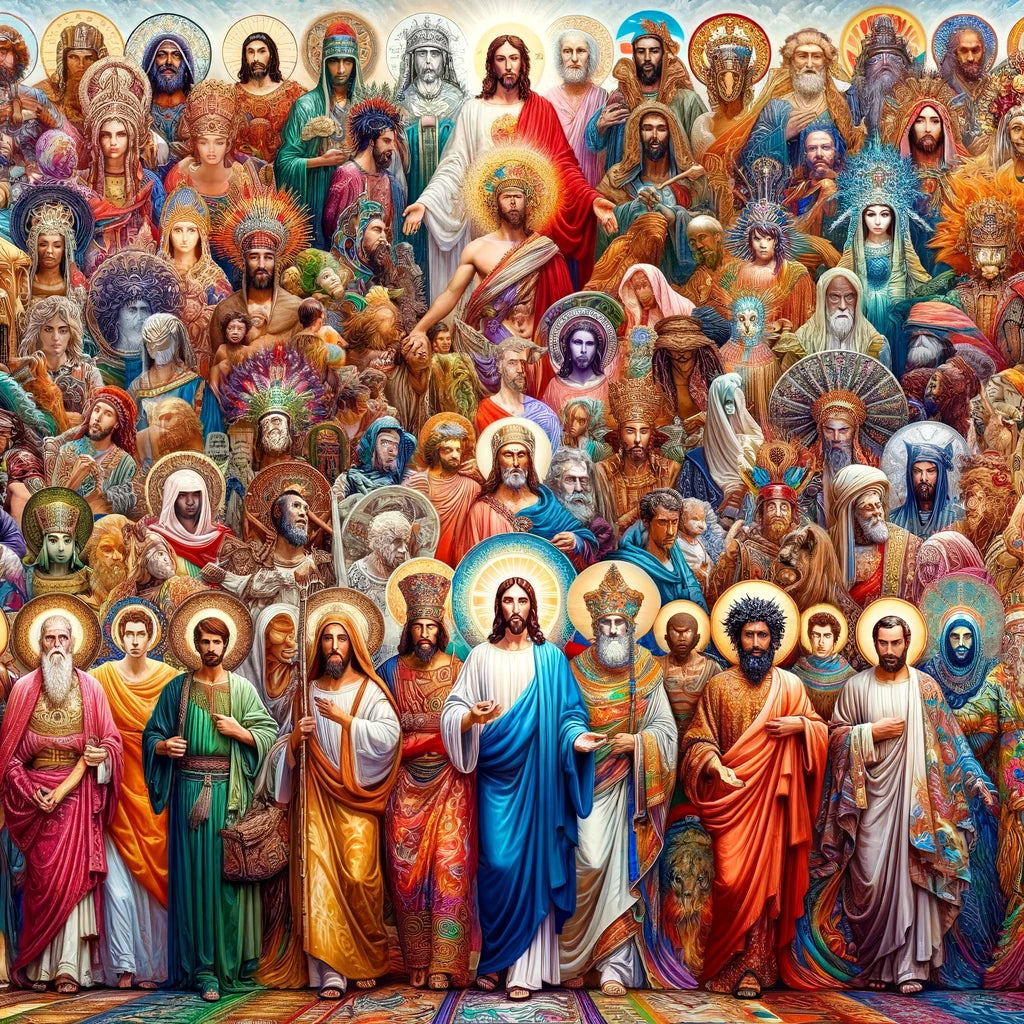
What Ethnicity Was Jesus
Share
Many have wondered: what ethnicity was Jesus? For centuries, people have debated his racial identity. Was he Nordic? Aryan? Semitic? Black?


 Our investigation suggests Jesus was Jewish and from Western Asia, likely having olive-colored skin, resembling a typical Galilean Semite of his time. Jesus' precise ethnicity remains unknown.
Our investigation suggests Jesus was Jewish and from Western Asia, likely having olive-colored skin, resembling a typical Galilean Semite of his time. Jesus' precise ethnicity remains unknown.













Key Takeaways
- Jesus was likely a Judean from Galilee with a lean appearance, brown or black hair, honey or olive-brown skin, and brown eyes.
- Depictions of Jesus throughout history have been influenced by cultural, political, and theological factors, leading to diverse portrayals.
- Quranic and Muslim traditions vary in their descriptions of Jesus' appearance, mentioning features such as curly hair, a reddish complexion, and a wheatish complexion with straight hair.
- Historical analysis suggest that Jesus would have had a Middle Eastern appearance, with olive-colored skin, a broad face, a large nose, and short, curly hair.
- Ultimately, Jesus' message and our united values matter far more than ethnicity. Jesus taught that we are to love one another as he loves us. Our diversity is something to celebrate and our faith is something that can bring us together as one family with God as our father.

What Ethnicity Was Jesus
For centuries, Christians of all denominations have been captivated by portraits of Jesus. Some have sought to understand the ethnicity of the person depicted.Brief Explanation of the Significance of Jesus Portraits in Christian Worship
By understanding the significance of Jesus portraits in Christian worship, we can gain insight into the question of what ethnicity Jesus was. Portraits of Jesus have been used for centuries in Christian worship, with the earliest known artworks dating to the mid-third century A.D. Jesus portraits are often used to impart religious teachings in society and can reflect regional cultures, political circumstances, and theological contexts. Such depictions carry spiritual significance and help to reinforce the teachings of Christianity, the Bible, and Jesus Christ.
Understanding the Ethnicity of Jesus in Relation to Cultural and Historical Contexts
As we explore Jesus' ethnicity in relation to cultural and historical contexts, it's helpful to visit how this has been interpreted and debated throughout history. Jesus' ethnicity has been the subject of much debate among scholars and historians. In this article, we'll explore the limited information available in the Bible regarding Jesus' ethnicity. Additionally, we will examine hypotheses and theories about Jesus' appearance based on historical and biblical evidence. This will give us insight into how Jesus may have looked physically, based on the available information.
Understanding the Cultural and Racial Context of the Time Jesus Lived In
By exploring the cultural and racial context of the time Jesus lived in, we can better unravel the mystery of his ethnicity. Jesus lived during the Roman Empire, which had a profound influence on the region. Judaism was the predominant religion at the time, and God was the unifying force in the culture. Although there's a lack of direct biblical or historical references to Jesus' ethnicity, a number of sources provide insight. Ultimately, Jesus' physical appearance was likely influenced by his Middle Eastern heritage. Our investigation suggests Jesus was Jewish and from Western Asia, likely having olive-colored skin, resembling a typical Galilean Semite of his time. Jesus' precise ethnicity remains unknown.
Our investigation suggests Jesus was Jewish and from Western Asia, likely having olive-colored skin, resembling a typical Galilean Semite of his time. Jesus' precise ethnicity remains unknown.
Jesus in Historical Context: Ethnicity and Cultural Identity
In this article, we'll explore the ethnicities and cultural identity of Jesus within the Galilean region during his time. We will examine the role of Roman occupation in influencing the demographics of the region and the impact of cultural identity on Jesus' ministry and teachings. First, let's explore the ethnicities present in Galilee during Jesus' time. Galilee was a diverse region, with a mixture of Jewish, Greek, and Roman populations. Jews formed the majority, but there were also significant numbers of Greeks and Romans, largely due to the Roman occupation. The Roman occupation played a crucial role in shaping the demographics of the region. The Romans brought with them their own culture and customs, which inevitably influenced the local population. This influence can be seen in various aspects of daily life, such as language, clothing styles, and even religious practices. Despite the presence of these different ethnic groups, Jesus himself was ethnically Jewish. He was born into a Jewish family and grew up in a predominantly Jewish community. This Jewish identity would have undoubtedly shaped his cultural upbringing and influenced his teachings and ministry. As a Jewish man, Jesus was deeply rooted in the traditions, laws, and beliefs of Judaism. Many of his teachings and parables drew heavily from Jewish scripture and tradition. This cultural background allowed him to connect with and relate to the Jewish community, making his message more accessible and relatable.
Considering the Influence of Roman Occupation on the Demographics of the Region
Using our knowledge of the Roman occupation in the Galilean region, we can see how it impacted the ethnic composition of the area during Jesus' lifetime. John the Baptist was active in the region prior to Jesus' arrival, and Roman forces had already begun to assimilate local cultures into their own. This process led to a blend of ethnicities, with Greeks, Jews, and Romans all living side-by-side in the region. The white population in the area was largely of Greek and Roman origin, while the local Jews maintained their distinct identity. The Roman presence also encouraged a wider variety of cultural influences, from trade and commerce to religious ideas. This melting pot of cultures likely impacted Jesus' own cultural identity and contributed to the diversity of his teachings.

Portrayals of Jesus Throughout History: Reflections of Cultural Interpretations
Throughout history, Jesus has been depicted in various ways, reflecting cultural biases and interpretations. To gain an understanding of the impact of these portrayals, we must look at early depictions of Jesus in Western art and the cultural and racial influences that have shaped them. We trace the evolution of Jesus' images in Western art from early depictions to modern interpretations, reflecting the cultural interpretations of each era. From Mathew's account of Jesus, we can gather he was a Middle Eastern man of Galilean Semite race. Over time, the depiction of this figure has been subject to artistic interpretation. The cultural interpretation and portrayal of Jesus has changed over time, reflecting the current beliefs and values of each era.

Encouraging a Respectful and Inclusive Approach to Portraying Jesus in Diverse Cultural Contexts
In order to foster a respectful and inclusive approach to portraying Jesus in diverse cultural contexts, it's important to consider the challenges and cultural sensitivities surrounding his ethnicity. Contemporary debates about Jesus' race have been based on cultural stereotypes and societal trends. It's essential to recognize the importance of being respectful of the many christian communities who draw on different interpretations of Jesus' ethnicity and identity. The goal should be to promote a discourse that's open to different cultural perspectives on Jesus' race and most importantly to cultivate respect and inclusivity.
Recognizing the Limitations of Visual Representations and Focusing on the Core Teachings of Jesus
Moving forward, it's necessary to recognize the limitations of visual representations of Jesus and focus instead on the core teachings that have been passed down to us. We must strive to approach the question of Jesus' ethnicity with respect, understanding, and sensitivity. More important, however, is to understand the essence of Jesus- his spirit, his mission, and his message of oneness as members of the family of God the father.Appreciating the Diversity of Jesus' Followers: Unity in Faith
As followers of Jesus, we can appreciate the diversity of his followers around the world, regardless of our ethnicity.Celebrating the Global Nature of Spirituality and Its Diverse Cultural Expressions
Celebrating the unity in faith among Jesus' diverse followers around the world, we appreciate the global nature of Christianity and its various cultural expressions.
Emphasizing the Shared Values and Teachings That Unite Believers Regardless of Ethnicity
We all have at least one thing in common: a shared appreciation for the values and teachings of Jesus, regardless of our ethnicity. The son of God has inspired generations of believers, and while we may come from different cultures and backgrounds, we're unified in our love for him and commitment to follow him and love as he did. Our shared values transcend racial and national boundaries. We're all children of the same God, and we can use our faith to bring us together in a spirit of unity and understanding. We should seek to encourage a deeper understanding and appreciation of the diverse backgrounds of Jesus' followers, as well as the shared values and teachings that unite us all.









